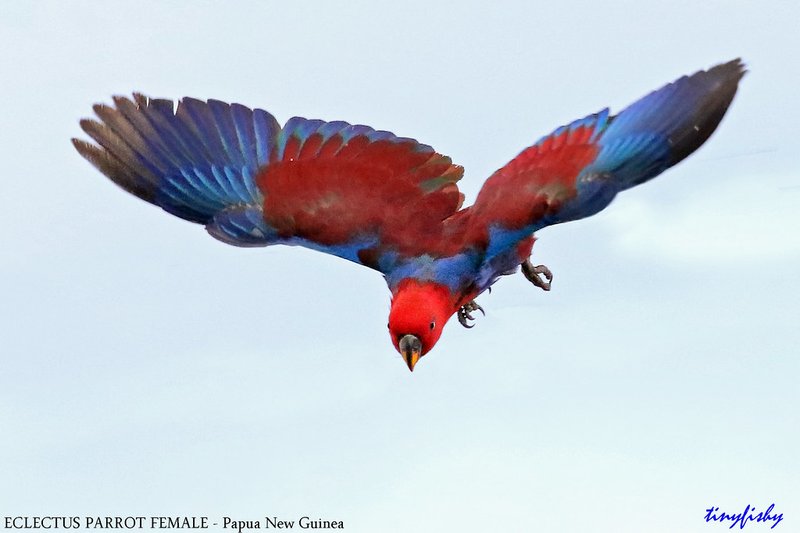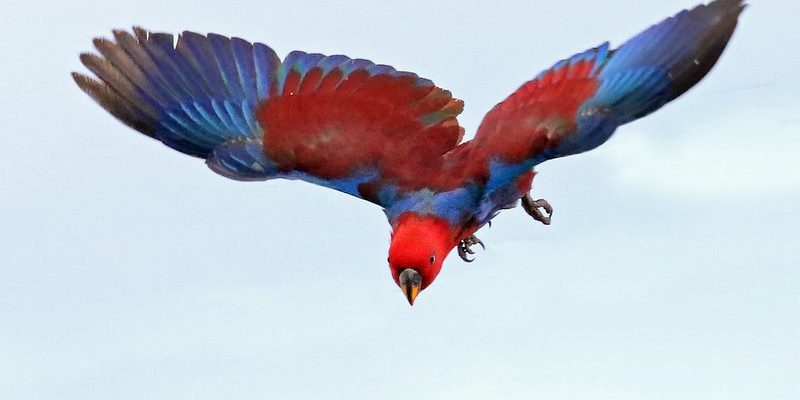
Imagine, for a moment, you’re sitting in a lush rainforest, sipping a coffee while vibrant flashes of green and red zip by. That’s the Eclectus parrot in action! They utilize their unique flying techniques to navigate through dense foliage, often surprising onlookers with their agility and intelligence. Let’s dive into the world of these remarkable birds to explore their flying skills, hunting habits, and what makes them so special.
The Flying Skills of the Eclectus Parrot
The flying abilities of the Eclectus parrot are truly remarkable. When you watch them soar through the trees, it’s clear they’re not just flapping their wings aimlessly. Instead, they exhibit graceful flight patterns that help them expertly maneuver through their forest habitat.
One thing you might notice is how these parrots use their wings. Unlike some birds that rely heavily on speed, Eclectus parrots often glide smoothly from branch to branch. This conserves energy and allows them to stay hidden from predators. Imagine a skilled gymnast—each movement is deliberate and practiced, showing both strength and elegance. Their wingspan is around 18 inches, which helps them make sharp turns and quick ascents, enhancing their ability to evade threats.
When you think about it, their flying style is essential for survival. The Eclectus parrot primarily lives in the humid forests of the Solomon Islands, New Guinea, and parts of Australia, where dense foliage is the norm. Their less aggressive flight allows them to blend in with the environment, making it harder for predators like hawks to spot them. It’s all about being smart and stealthy.
Unique Wing Structure and Flight Mechanics
The anatomy of the Eclectus parrot’s wings plays a crucial role in how they fly. Their wings are broad and long in proportion to their bodies, which is a little different from many other parrots. This wing structure allows them to glide effortlessly through the trees, offering both speed and maneuverability.
One of the fascinating aspects is their feather design. The feathers themselves are not just for color—they also serve a functional purpose. With a higher percentage of their feathers being primary flight feathers, they can generate lift more effectively. Think of it as choosing the right tools for a job; having the right feathers means they can fly efficiently without expending too much energy.
Equally important is their tail feathers, which are long and shaped like a fan. These allow for precise steering during flight. When you watch them make a sharp turn, you can see how those tail feathers help them navigate through tight spaces, much like a skilled driver handling sharp corners on a racetrack. It’s this combination of wing and tail dynamics that sets them apart in the avian world.
Hunting Techniques: Foraging for Food
When it comes to hunting—or, more appropriately, foraging—Eclectus parrots have developed their own set of techniques that reflect their intelligence and adaptability. While they may not be traditional hunters, they’re expert foragers, primarily feeding on fruits, nuts, and seeds found in their forest homes.
Eclectus parrots have a unique way of selecting food. They often begin by using their keen eyesight to spot ripe fruits high in trees. Once they’ve spotted a meal, they’ll fly in close, using their powerful beaks to navigate the tough outer skins of fruits. Their strong, sharp beaks can easily crack open tough nuts, allowing them to get to the nutritious meat inside.
Another interesting aspect of their foraging behavior is their social structure. Eclectus parrots are often seen foraging in small groups. This not only makes the process more efficient but also provides safety in numbers. While one parrot keeps watch for potential predators, the rest can focus on hunting down their next meal. It’s a clever strategy, much like a team of friends working together to achieve a common goal.
Adaptability and Intelligence
Eclectus parrots are not only skilled fliers and foragers, but they also showcase remarkable adaptability. Their ability to thrive in various habitats, from rainforests to woodlands, is a testament to their intelligence. This adaptability is crucial for survival, especially as their environment changes.
This intelligence is particularly highlighted in their problem-solving skills. When faced with challenges—like reaching food in hard-to-get places—they might use tools or demonstrate clever strategies to extract their meal. For instance, some may drop hard seeds from a height to break them open, showcasing a level of creativity that indicates they’re more than just pretty birds.
Their social behavior also reflects their intelligence. They engage in vocalizations and mimicry, often imitating sounds from their surroundings. This not only helps them communicate with each other but often allows them to blend into their environment more effectively, avoiding predators while foraging. It’s a mix of adaptability and cleverness that makes them truly unique.
The Eclectus parrot is a perfect example of how fascinating nature can be. Their flying and hunting techniques demonstrate a complex balance between beauty, skill, and intelligence. Watching them soar through the trees is like seeing a well-coordinated dance, where each movement is purposeful and graceful.
These parrots also remind us of the incredible diversity of life. Their vibrant songs, colorful feathers, and clever foraging methods reflect a world where every creature has its unique role. So, if you ever find yourself in a rainforest, keep an eye out for these remarkable birds. You might just catch a glimpse of them in action, turning the ordinary into something extraordinary.

